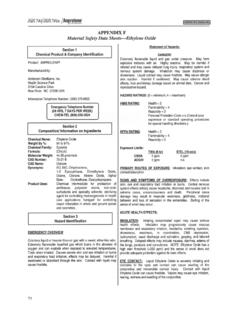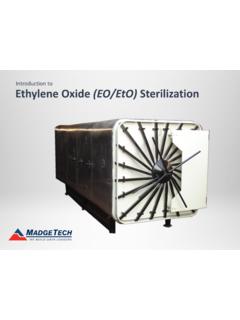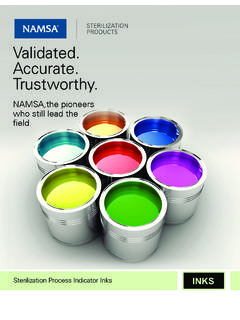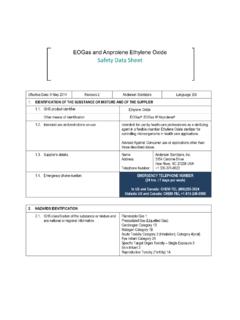Transcription of Material Safety Data Sheet ETHYLENE OXIDE …
1 Product: ETHYLENE OXIDE Manufactured by: ARC SPECIALTY PRODUCTS BALCHEM CORPORATION 52 Sunrise Park Road New Hampton, New York 10958 Information Telephone: (845) 326-5611 CHEMICAL NAME: ETHYLENE OXIDE WEIGHT BY %: 100% CHEMICAL FAMILY: Epoxide FORMULA: (CH2)2O MOLECULAR WEIGHT: gms/mole CAS NUMBER: 75-21-8 CAS NAME: Oxirane SYNONYMS: EO, EtO, Dihydroxirene, 1-2 Epoxyethane, Dimethylene OXIDE , Oxane, Oxirane, Alkene OXIDE , Alpha/Beta-Oxidoethane, Oxacyclopropane. PRODUCT USES: Chemical intermediate for production of anti-freeze, polyester resins, non-ionic surfactants and specialty solvents; sterilizing agent for controlling microorganisms in health care applications; fumigant for controlling insect infestation in whole and ground spices and cosmetics.
2 EMERGENCY OVERVIEW Colorless liquid or heavier-than-air gas with a sweet, ether-like odor. Extremely flammable liquified gas which burns in the absence of oxygen and can explode when exposed to elevated temperatures. Toxic when inhaled. Causes severe skin and eye irritation or burns and respiratory tract irritation; effects may be delayed. Harmful if swallowed or absorbed through the skin. Contact with liquid may cause frostbite. Statement of Hazards: DANGER! Extremely flammable liquid and gas under pressure. May form explosive mixtures with air. Highly Reactive. Harmful or fatal if inhaled and may cause delayed lung injury, respiratory system and nervous system damage. Inhalation may cause dizziness or drowsiness.
3 Liquid contact may cause frostbite. May cause allergic skin reaction. Harmful if swallowed. May cause adverse blood effects, liver and kidney damage based on animal data. Cancer and reproductive hazard. HAZARD RATINGS: (0 = minimum; 4 = maximum) HMIS Rating: Health = 3 Flammability = 4 Reactivity = 3 Personal Protection Code = X (Consult your supervisor or standard operating procedures for special handling directions.) NFPA Rating: Health = 3 Flammability = 4 Reactivity = 3 Exposure Limits: TWA (8-hr) STEL (15-min) OSHA 1 ppm 5 ppm ACGIH 1 ppm n/a PRIMARY ROUTES OF EXPOSURE: Inhalation; eye contact; skin contact/absorption.
4 SIGNS AND SYMPTOMS OF OVEREXPOSURE: Effects include skin, eye and respiratory tract irritation or burns. Central nervous system effects initially cause headache, dizziness and nausea and in extreme cases, unconsciousness and death. Peripheral nerve damage may result in muscular weakness, giddiness, irrational behavior and loss of sensation in the extremities. Dulling of the sense of smell may occur. ACUTE HEALTH EFFECTS: INHALATION: Inhaling concentrated vapor may cause serious health effects, possibly death. Inhalation may progressively cause mucous membrane and respiratory irritation, headache, vomiting, cyanosis, drowsiness, weakness, incoordination, CNS depression, lachrymation, nasal discharge and salivation, gasping, and labored breathing.
5 Delayed effects may include nausea, diarrhea, edema of the lungs, paralysis, convulsions and possibly death. NOTE: ETHYLENE OXIDE has a high odor threshold (> 250 ppm) and the sense of smell does not provide adequate protection against its toxic effects. EYE CONTACT: Liquid ETHYLENE OXIDE is severely irritating and corrosive to the eyes and contact can cause swelling of the conjunctiva and irreversible corneal injury. Contact with liquid ETHYLENE OXIDE can cause frostbite. Vapors may cause eye irritation, tearing, redness and swelling of the conjunctiva. SKIN CONTACT: Prolonged contact with liquid ETHYLENE OXIDE can cause a local erythema, edema, and formation of blisters. Page1of6 Section 1 Chemical Product & Company Identification EMERGENCY TELEPHONE (24 per week): CHEMTREC (800) 424-9300 OUTSIDE & CANADA (703) 527-3887 (Collect calls accepted) ) Section 2 Composition/Information on Ingredients Section 3 Hazard Identification Material Safety Data Sheet ETHYLENE OXIDE Response is more severe on damp skin.
6 There may be a latency period of several hours prior to the onset of symptoms. ETHYLENE OXIDE may be absorbed by the skin, and sustained contact may produce adverse effects such as headache, dizziness, nausea and vomiting. ETHYLENE OXIDE is a skin sensitizer and some individuals may suffer an allergic skin reaction. Skin contact may also cause allergic contact dermatitis in some exposed individuals. Liquid ETHYLENE OXIDE evaporates rapidly and may chill the skin causing frostbite. INGESTION: This relatively unlikely route of exposure is expected to cause severe irritation and burns of the mouth and throat, abdominal pain, nausea, vomiting, collapse and coma. Aspiration may occur during swallowing or vomiting, resulting in lung damage.
7 CHRONIC HEALTH EFFECTS: SKIN CONTACT: Long term effects are unknown but are expected to be similar to acute effects of skin exposure. EYE CONTACT: Some cases of cataract formation have been reported. INHALATION: Respiratory irritation which can result in permanent lung injury, chromosomal aberrations and peripheral neurotoxic effects with a numbing of the sense of smell. Cognitive and CNS impairment may result from long term exposures. INGESTION: May cause anemia, gastrointestinal irritation, effects on liver, kidneys, and adrenal glands. CARCINOGENICITY: OSHA classifies ETHYLENE OXIDE as a cancer/reproductive hazard and considers that, at excessive levels, ETHYLENE OXIDE may present reproductive, mutagenic, genotoxic, neurologic and skin sensitization hazards.
8 ACGIH classifies ETHYLENE OXIDE as "A2" - suspected human carcinogen. NTP classifies ETHYLENE OXIDE as a known human carcinogen. IARC classifies ETHYLENE OXIDE in Group I (carcinogenic to humans). NIOSH classifies ETHYLENE OXIDE as a potential human carcinogen. EYE CONTACT: Immediately flush eyes, including the entire surface of the eyes and under the eyelids, gently but thoroughly with plenty of running water for at least 15 minutes. Obtain medical attention immediately. NOTE: Never wear contact lenses when working with ETHYLENE OXIDE . SKIN CONTACT: Immediately flush skin thoroughly with water for at least 15 minutes while removing contaminated clothing and shoes. Obtain medical attention immediately. Treat for possible cryogenic injury, if needed by warming affected areas with warm water (wrap with a blanket if warm water is not available).
9 Wash clothing before reuse and discard contaminated leather articles such as shoes and belts. INHALATION: Remove exposed person to fresh air. If breathing has stopped, give artificial respiration then have qualified personnel administer oxygen, if needed. Get immediate medical attention. INGESTION: If patient is conscious give plenty of water (minimum of two glasses) but DO NOT INDUCE VOMITING. This Material is corrosive. Keep head lower than hips to avoid aspiration, should vomiting occur. Get medical attention immediately. MEDICAL CONDITIONS AGGRAVATED BY EXPOSURE: Preexisting skin, eye and respiratory disorders; lung, blood, nervous system and peripheral nerve disorders. NOTE TO PHYSICIANS: Respiratory symptoms include nausea, vomiting and irritation of the nose and throat.
10 Pulmonary edema may occur. Respiratory effects may be delayed. Consider oxygen administration. If a chemical burn is present, -decontaminate skin and treat as any thermal burn. No specific antidote is known, however consider gastric lavage and administration of a charcoal slurry. FLASH POINT (Test Method): Tag Closed Cup: -4 F (-20 C) FLAMMABLE LIMITS IN AIR (% BY VOLUME): Upper flammable limit: 100% Lower flammable limit: NFPA HAZARD RATING: Health: 3; Flammability: 4; Reactivity: 3 AUTO IGNITION TEMPERATURE: 804 F (429 C); Burns in the absence of air SPECIAL FIRE-FIGHTING PROCEDURES: Wear NIOSH-approved self-contained breathing apparatus (SCBA) operated in the pressure-demand mode and full chemical-resistant protective clothing.








